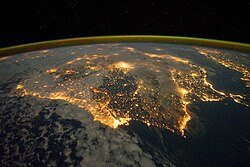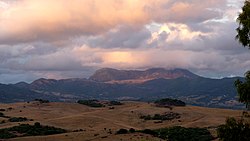Iberiska halvön


Iberiska halvön (spanska och portugisiska: Península Ibérica)[1], eller Pyreneiska halvön[2], är en halvö i sydvästra Europa, bestående av de självständiga staterna Spanien, Portugal och Andorra, det brittiska territoriet Gibraltar och en del av det franska departementet Pyrénées-Orientales. Halvön är, med en areal av 583 254 km², den näst största i Europa efter Skandinaviska halvön.
Halvön avgränsas mot syd och öst av Medelhavet och mot väst och norr av Atlanten. I nordöst bildar bergskedjan Pyrenéerna gräns mot Frankrike.[1] Längst i söder separerar Gibraltar sund halvön från Afrika (Marocko) och spanska exklaven Ceuta.
Namnet "iberiska" kommer av ibererna, ett folkslag som bodde på halvön innan den införlivades med Romarriket. Namnet "pyreneiska" kommer av Pyrene, en nymf i den grekiska mytologin.
Hispania var romarnas benämning på Pyreneiska halvön och sannolikt dess äldsta namn.[3]
Bilder
- Satellitbild över halvön med snötäckta delar efter stormen Filomena
- Halvön på natten
- Iberiskt landskap
- Iberiskt landskap
- Iberiskt landskap
- Västkusten
Referenser
- Iberiska halfön i Nordisk familjebok (andra upplagan, 1910)
- ^ [a b] ”Península Ibérica” (på portugisiska). Infopédia. Porto Editora. https://www.infopedia.pt/apoio/artigos/$peninsula-iberica. Läst 18 augusti 2022.
- ^ Pyreneiska halvön i Nationalencyklopedins nätupplaga. Läst 26 september 2017.
- ^ Hispania i Nordisk familjebok (andra upplagan, 1909)
Externa länkar
 Wikimedia Commons har media som rör Iberiska halvön.
Wikimedia Commons har media som rör Iberiska halvön.
Media som används på denna webbplats
Heavy snowfall brought by Storm Filomena hit Spain in January 2021, and persisted on the ground for many days across much of the country, as this Copernicus Sentinel-3 satellite image shows.
During this period, temperatures plunged to −35.8 °C at Vega de Liordes [1] in the Picos de Europa, a new lowest temperature record for the country. The city of Teruel, east of Madrid, reached -25 ºC, while another seven province capitals also reached temperatures under -10 ºC, overall Spain's coldest night in at least 20 years [2].
Madrid had its heaviest snowfall in five decades, reaching up to 60 cm in accumulation [3]. It was one of the worst affected areas, being unprepared for this amount of snow, and being brought to a standstill with the airport having to be closed, trains cancelled and roads blocked. People in central Spain struggled with the deep freeze that followed the heavy snow.
While the idea of snuggling under a blanket in the cold winter months is very appealing, the blanket that covers half of Spain is not remotely comforting. This satellite image, captured on 12 January at 11:40 CET, shows much of the country facing hazardous conditions following the snow that fell during the weekend of the 8th - 10th of January.
Copernicus Sentinel-3 is a two-satellite mission. Each satellite carries a suite of cutting-edge instruments to measure systematically Earth’s oceans, land, ice and atmosphere to monitor and understand large-scale global dynamics. For example, with a swath width of 1270 km, the ocean and land colour instrument, which acquired the two tiles for this image, provides global coverage every two days.
Författare/Upphovsman: ManuelGR, Licens: CC BY-SA 3.0
Main rivers of the Iberian peninsula with their names in Spanish and Portuguese. Created with GMT program and edited with GIMP. XCF version in Image:Rios_peninsula_Iberica-es.xcf
- Description: Blank map of Europe * Source: SVG trace of PNG of the same name. Original PNG based on CIA map The World Factbook * Author: PNG author: San Jose, 19. July 2006. SVG trace by RedHotHeat 06 August 2006
Författare/Upphovsman: gailhampshire from Cradley, Malvern, U.K, Licens: CC BY 2.0
P1300282
Författare/Upphovsman: gailhampshire from Cradley, Malvern, U.K, Licens: CC BY 2.0
P1300283
Författare/Upphovsman: michael clarke stuff, Licens: CC BY-SA 2.0
West coast174
Författare/Upphovsman: NASA's Earth Observatory, Licens: CC BY 2.0
To download the full resolution and other files go to: earthobservatory.nasa.gov/IOTD/view.php?id=76777&src=...
The city lights of Spain and Portugal define the Iberian Peninsula in this photograph from the International Space Station (ISS). Several large metropolitan areas are visible, marked by their relatively large and brightly lit areas, including the capital cities of Madrid, Spain—located near the center of the peninsula’s interior—and Lisbon, Portugal—located along the southwestern coastline. The ancient city of Seville, visible to the north of the Strait of Gibraltar, is one of the largest cities in Spain. The astronaut view is looking toward the east, and is part of a time-lapse series of images.
The network of smaller cities and towns along the coastline and in the interior attest to the extent of the human presence on the Iberian landscape. The blurring of city lights is caused by thin cloud cover (image left and center), while cloud tops are dimly illuminated by moonlight. Though obscured, the lights of France are visible near the horizon line on the upper left, while the lights of northern Africa are more clearly discernable at right. The faint gold and green line of airglow—caused by ultraviolet radiation exciting the gas molecules in the upper atmosphere—parallels the horizon (or Earth limb).
The Iberian Peninsula is the southwestern-most of the European peninsulas (together with the Italian and Balkan peninsulas), and includes the Principality of Andorra, as well as the Kingdom of Spain and the Portuguese Republic. The approximately 590,000 square kilometer landmass is bounded by the Atlantic Ocean to the northwest, west, and southwest and the Mediterranean Sea to the east. Its northeastern boundary is marked by the Pyrenees mountain range.
Astronaut photograph ISS030-E-10008 was acquired on December 4, 2011, with a Nikon D3S digital camera using a 24 mm lens, and is provided by the ISS Crew Earth Observations experiment and Image Science & Analysis Laboratory, Johnson Space Center. The image was taken by the Expedition 30 crew. The image has been cropped and enhanced to improve contrast. Lens artifacts have been removed. The International Space Station Program supports the laboratory as part of the ISS National Lab to help astronauts take pictures of Earth that will be of the greatest value to scientists and the public, and to make those images freely available on the Internet. Additional images taken by astronauts and cosmonauts can be viewed at the NASA/JSC Gateway to Astronaut Photography of Earth. Caption by William L. Stefanov, Jacobs Technology/ESCG at NASA-JSC.
The Earth Observatory's mission is to share with the public the images, stories, and discoveries about climate and the environment that emerge from NASA research, including its satellite missions, in-the-field research, and climate models.
Like us on Facebook
Follow us on Twitter
Add us to your circles on Google+












